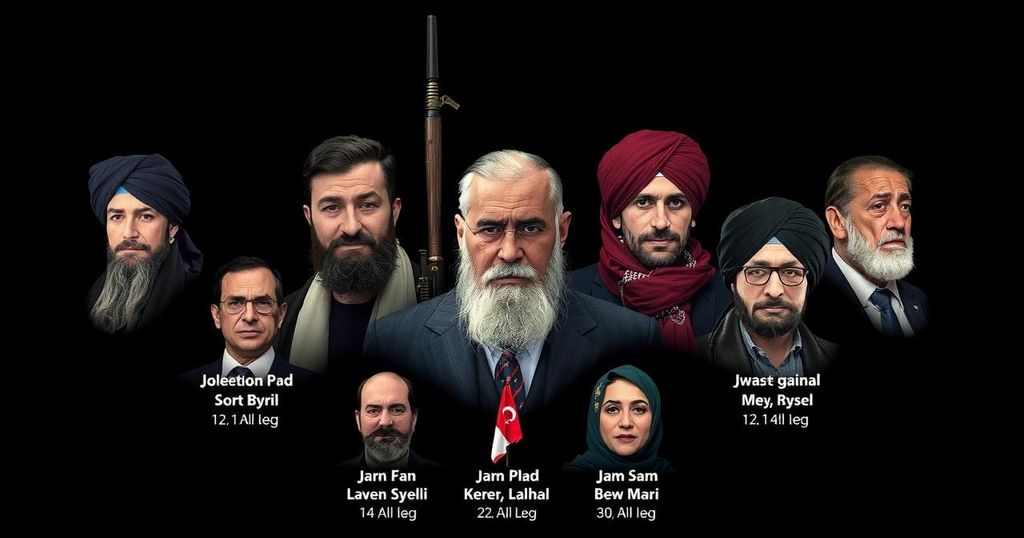World news
ABU MOHAMMED AL - GOLANI, AL - NAYRAB, ALEPPO, ANKARA, AP, ASIA, CURRENT EVENTS, EUROPE/ASIA, GOLAN HEIGHTS, IRAN, KHIRBET AMMU, LEVANT LIBERATION COMMITTEE, MIDDLE EAST, MINISTRY OF DEFENSE, OMAR ALBAM, PAVEL GOLOVKIN, PRIZES, QAMISHLI, REC, SYRIA, SYRIAN CENTRAL MILITARY, SYRIAN CENTRAL MILITARY MEDIA, TEHRAN, TURKEY, UGC, VLADIMIR PUTIN, WAR, ZONE
Lena Nguyen
0 Comments
Key Players in Syria’s Civil War Amid Rising Insurgent Advances
Syria’s civil war rekindles global concerns as rebel forces recently captured Aleppo, marking a notable shift in control. The conflict sees key players like Russia, Iran, and Turkey embroiled in a complex struggle, with increasing hostilities since the 2020 ceasefire. Insurgent groups, particularly Hayat Tahrir al-Sham, have gained ground amid the government’s shifting dynamics. Meanwhile, U.S.-backed Kurdish forces solidify control in the east, reflecting a multifaceted geopolitical landscape.
The Syrian civil war, ongoing since 2011, has recently gained renewed international focus following an unexpected offensive by rebel forces in Aleppo, marking the most significant clashes since the 2020 ceasefire. The rebel advance comes amid a shift in the dynamics of power among key players in the conflict, including weakened support for the Syrian government amid pressing issues in the backing nations. Russian and Syrian military operations aim to contain the insurgent threat through sustained airstrikes, but the impact of these assaults mirrors a chaotic battlefield where opposing factions vie for influence.
The Syrian government, under President Bashar Assad, has consistently received military aid from allies Russia and Iran. Their control over major urban centers has been pivotal in the ongoing conflict. Until recently, the regime’s military achievements included a decisive victory in Aleppo in 2016, which profoundly altered the war’s trajectory. However, the recent insurgent takeover signals a critical setback. While Iran’s support has faltered due to its preoccupations elsewhere, the regular influx of Iranian-backed militias, including Iraqi fighters, underscores their efforts to reinforce Assad’s position.
Opposition forces, primarily led by Hayat Tahrir al-Sham (HTS), have seized much of northwest Syria, bolstered by Turkish backing. This group has evolved from its origins as al-Qaida’s affiliate, emphasizing a shift toward governance and inclusivity. The Turkish influence remains significant in the conflict, with its forces actively engaging the Kurdish-led Syrian Democratic Forces (SDF) in various contested areas. Foreign fighters, including Chinese and Chechen troops, also contribute to the complex battlefield landscape.
The U.S.-backed Syrian Democratic Forces continue to maintain control over eastern regions, standing firm against remnants of the Islamic State. The U.S. presence, albeit modest with approximately 900 troops, reflects a commitment to preventing the terror group’s resurgence. Tensions persist as Turkey perceives the SDF as linked to the PKK, complicating the geopolitical scenario in Syria.
The conflict, with its multifaceted alliances and rivalries, reveals the intricacies of power among both domestic and international actors. As the struggle for control persists, the dynamics of influence continue to shift dramatically, demanding close scrutiny as events unfold.
The Syrian civil war began in 2011 following an uprising against President Bashar Assad’s regime, evolving into a complex conflict involving foreign powers and a multitude of factions. The conflict has drawn in several international forces, including the United States, Russia, Iran, and Turkey, each with their specific strategic interests. The rising presence of insurgent groups fostered increasing instability, emphasizing the war’s protracted nature. Recent insurgent advances have drawn global attention, overshadowing a relatively stable period after the 2020 ceasefire, revealing vulnerabilities among key players in the region.
In summary, the latest developments in Syria’s civil war signify a complicated interplay among various actors each jostling for power and influence. The rebel forces’ successful advance against government-held territories highlights the shifting military dynamics exacerbated by the weakening of traditional support structures for Assad. As local factions continue to vie for dominance, the implications of foreign involvement and evolving alliances remain paramount in understanding the war’s trajectory.
Original Source: apnews.com




Post Comment